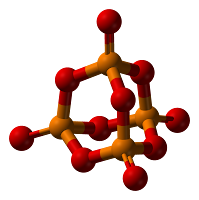Phosphorus is the chemical element that has the symbol P and atomic number 15. A multivalent nonmetal of the nitrogen group, phosphorus as a mineral is almost always present in its maximally oxidized state, as inorganic phosphate rocks. Elemental phosphorus exists in two major forms—white phosphorus and red phosphorus—but due to its high reactivity, phosphorus is never found as a free element on Earth.
The first form of elemental phosphorus to be produced (white phosphorus, in 1669) emits a faint glow upon exposure to oxygen – hence its name given from Greek mythology, Φωσφόρος meaning "light-bearer" (Latin Lucifer), referring to the "Morning Star", the planet Venus. Although the term "phosphorescence", meaning glow after illumination, derives from this property of phosphorus, the glow of phosphorus originates from oxidation of the white (but not red) phosphorus and should be called chemiluminescence.
The vast majority of phosphorus compounds are consumed as fertilizers. Other big applications include the role of organophosphorus compounds in detergents, pesticides and nerve agents, and matches.
Phosphorus is essential for life. As phosphate, it is a component of DNA, RNA, ATP, and also the phospholipids that form all cell membranes. Demonstrating the link between phosphorus and life, elemental phosphorus was historically first isolated from human urine, and bone ash was an important early phosphate source. Phosphate minerals are fossils. Low phosphate levels are an important limit to growth in some aquatic systems. Today, the most important commercial use of phosphorus-based chemicals is the production of fertilizers, to replace the phosphorus that plants remove from the soil.
Home » Diagnostic tests » Phosphorus


{ 0 komentar... Views All / Send Comment! }
Posting Komentar